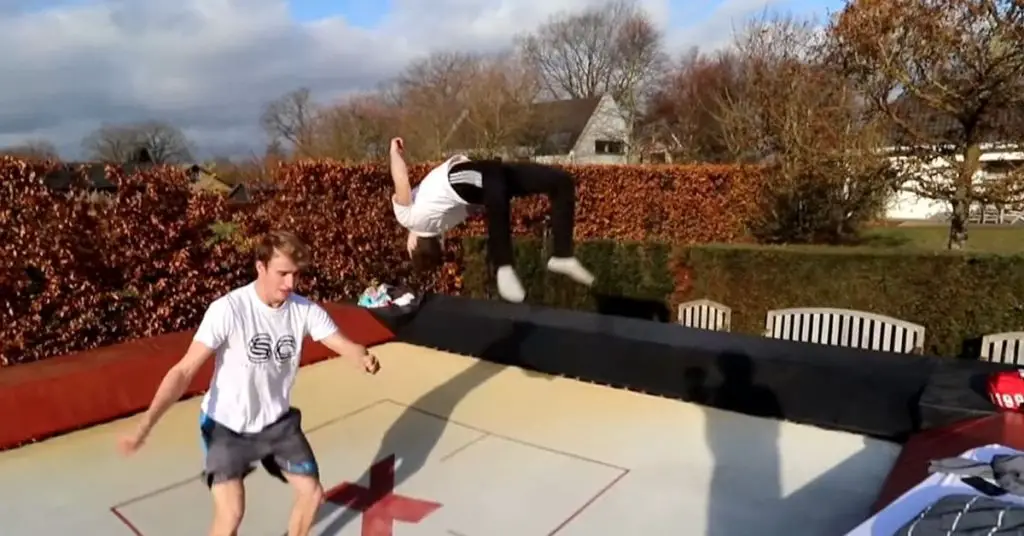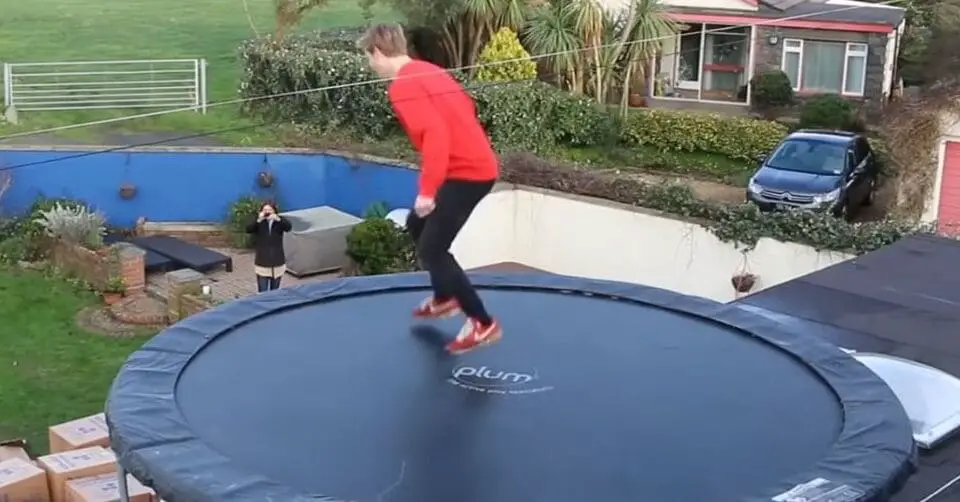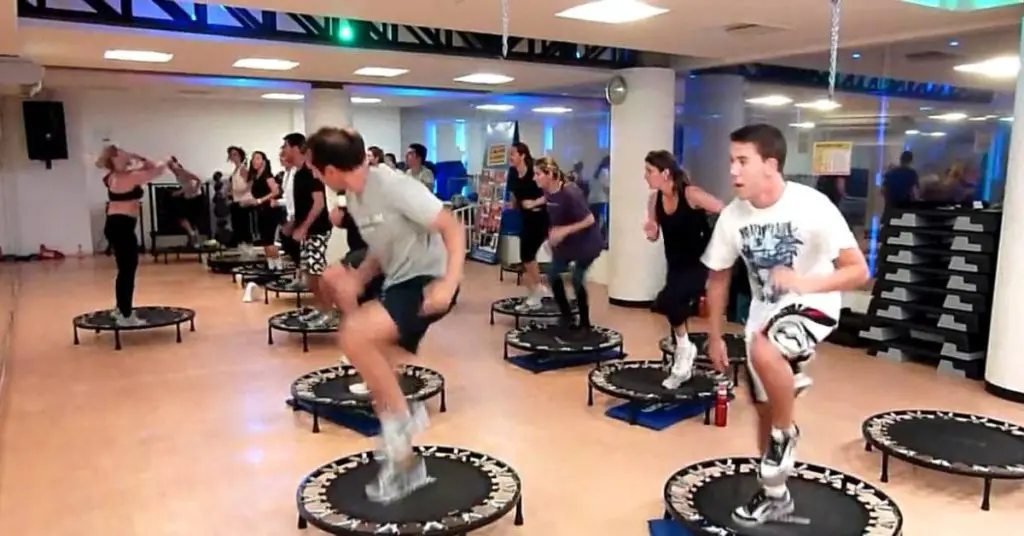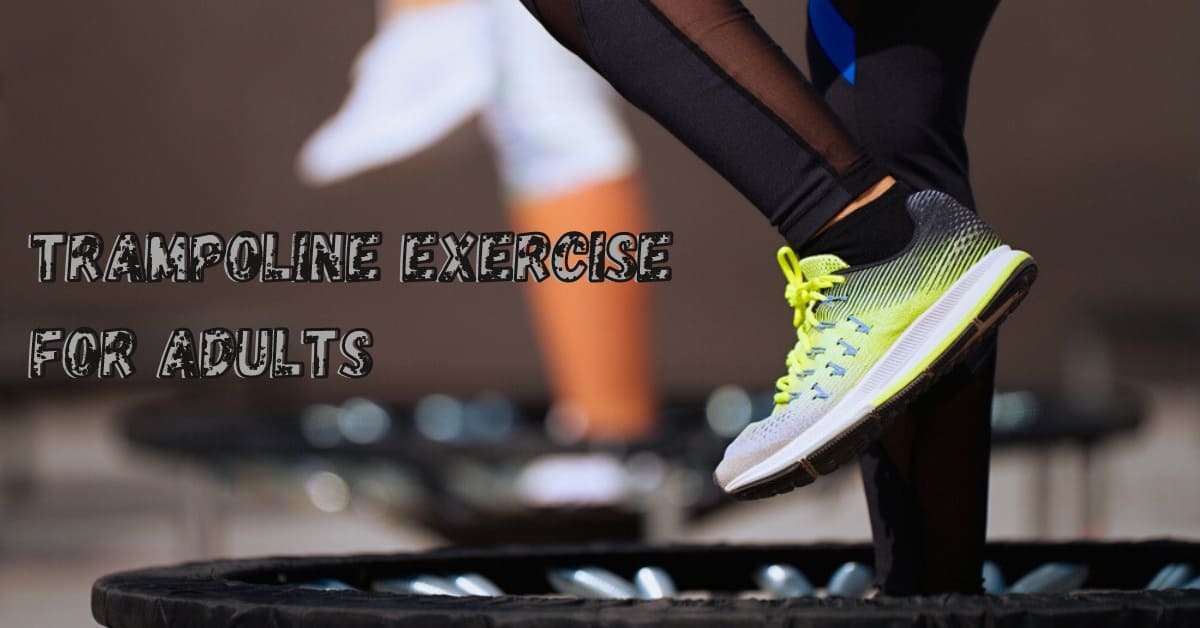Is Trampoline Good Exercise for Adults? According to research and studies, trampoline exercise can provide a variety of benefits for adults looking to improve their fitness levels.
It offers a low-impact workout that can be gentler on the joints than other forms of exercise, while still providing cardiovascular benefits and muscle strengthening.
The bouncing motion of the trampoline can also help to improve lymphatic circulation, which can aid in detoxification and boost the immune system. However, it is important to take precautions and follow safety guidelines when using a trampoline, as there is a risk of injury if not used properly.
With proper use and care, trampoline exercise can be a fun and effective way for adults to stay active and improve their overall health and fitness level.
Is Trampoline Good Exercise for Adults: Trampoline exercise can provide a low-impact, full-body workout for adults, improving cardiovascular fitness, muscle strength, and balance. However, precautions should be taken to avoid injury.
Mini Trampoline Exercises

Are you interested in trying out some fun and effective exercises to improve your fitness level? One option is to use a rebounder, also known as a mini trampoline.
Pelvic Floor Exercises Involving Jumps:
This exercise focuses on strengthening your pelvic floor and thigh muscles.
- To begin, place a small exercise ball or block between your knees.
- Slowly and gently jump up and down.
- As you jump, focus on engaging the muscles in your pelvic region.
- Squeeze the ball by engaging your inner thighs.
- Keep jumping and squeezing for 1 to 3 minutes.
By doing this exercise, you can strengthen your pelvic floor and thigh muscles, which can help with bladder control and support the lower back.
Exercises: Jumping Jacks

Jumping jacks are a classic exercise that can get your heart pumping and improve your overall fitness.
- To begin, stand with your feet together and your arms alongside your body.
- Next, jump up while lifting your arms overhead and spreading your legs out to the sides.
- As you land, bring your arms back down and your feet back together.
- Repeat these steps for 1 to 3 minutes.
- You can also slightly bend your torso forward if it feels more comfortable or raise your arms only up to shoulder height instead of overhead.
By doing this exercise, you can increase your heart rate, improve your coordination, and work on your upper and lower body muscles.
Exercises for Beginners
If you’re a beginner to trampoline jumping, begin with these exercises.
Variations of Jogging on a Trampoline:
Jogging on a trampoline can be a great way to improve your cardiovascular health and strengthen your leg muscles.
- Start by jogging from side to side a few times.
- Next, try jogging with a wider stance to work on your balance and stability.
- Then, raise your arms overhead while jogging to engage your upper body muscles.
- You can also try jogging sideways from side to side to target your inner and outer thigh muscles.
- Spend 1 to 2 minutes on each variation, and make sure to keep a steady and controlled pace throughout.
By doing these jogging variations, you can challenge your body in different ways and improve your overall fitness level.
Single-Leg Bounces on a Trampoline:
Single-leg bounces on a trampoline are a great way to strengthen your ankles and improve your balance.
- Start by standing with your feet hip-distance apart.
- Shift your weight onto your left foot and lift your right foot off the trampoline.
- Begin bouncing up and down on your left foot, keeping your knee aligned over your ankle to maintain proper form.
- Continue bouncing for up to 2 minutes, then switch to your right foot and repeat the exercise.
- Make sure to engage your core muscles to maintain balance throughout the movement.
By doing single-leg bounces regularly, you can build strength and stability in your ankles, which can help reduce your risk of injuries and improve your overall performance on and off the trampoline.
Large Trampoline Exercises

In this section, we will cover six different exercises that are specifically designed for large trampolines. If you are new to trampoline exercises, we suggest watching the video provided to get an idea of the basic movements.
These exercises can help you improve your balance, coordination, and cardiovascular fitness while having fun. The large trampoline provides a greater surface area, allowing you to perform more complex movements and jump higher.
Whether you are looking for a new way to stay active or just want to mix up your exercise routine, these exercises can be a great addition to your fitness regimen. So let’s dive in and see what moves you can try on a large trampoline!
Exercise 1: Butt Kicker Jumps
- Start by standing upright and begin jogging in place.
- As you jog, bend your knees and kick your feet back toward your butt one at a time.
- For a greater challenge, jump up and bring both feet towards your butt at the same time.
- Keep doing the exercise for 1 to 3 minutes.
Exercise 2: Seat Drops
- Start by standing on the trampoline and jump up while extending your legs straight out.
- As you come back down, land on your bottom with your legs still straight out.
- To help with balance, you can put your hands down on the trampoline.
- Get back up to standing and repeat this movement for 1 to 3 minutes.
Exercise 3: Twists
- Stand with feet hip-width apart and arms by your sides.
- Jump up and turn your legs to the left while twisting your upper body to the right.
- Land and return to the starting position.
- Repeat the same movement to the right.
- Do 8 to 16 repetitions for 1 to 3 sets.
Exercise 4: Pike Jumps
- Stand up straight with your arms beside your body and your feet flat on the trampoline surface.
- Jump up and stretch out your legs in front of you.
- Extend your arms straight towards your feet.
- Do this exercise for 1 to 3 minutes.
Exercise 5: Squat Jumps
- Stand with your feet apart and your arms at your sides.
- Jump up and land with your feet further apart.
- Bend your knees and lower your body until your thighs are parallel to the ground.
- Extend your arms straight out in front of you.
- Stand back up to the starting position.
- Repeat 8 to 12 times, and do 1 to 3 sets.
Exercise 6: Tuck Jumps
- Stand with your feet hip-distance apart and your arms at your sides.
- Jump up and bring both knees up towards your chest.
- When you land, immediately jump up again without pausing.
- For more of a challenge, try doing a tuck jump every time you land.
- Repeat the exercise for 1 to 3 minutes.
Exercises for Older Adults
These exercises are great for older people who want to exercise without putting too much pressure on their bodies.
Jumping Straight Up:
- Jump up from a standing position with your legs together.
- As you jump, lift your arms up over your head.
- Then come back down to the starting position.
- Do this exercise repeatedly for 1 to 3 minutes.
Jogging Exercises:
To do regular jogging, stand up straight or slightly lean back. Then lift your knees up and down, as if you were running in place. As you do this, move your arms back and forth in the opposite direction of your legs. Keep doing this for one to four minutes.
Alternative Exercises
If you don’t have a trampoline, you can still do exercises that are similar to those done on a trampoline. Here are a few examples:
Box Jumps Exercise:
Please stand on the right side of the box. Bend your knees and jump over the box, landing on the left side. Jump back to where you started. This counts as one repetition. You can do this 8 to 14 times in a row, and then take a break. You can repeat this one to three times.
Squats Jumping:

Start by standing with your feet a little wider than your hips. Slowly lower your hips down to get into a low squat position. Use your stomach muscles to push into your feet and jump as high as you can.
At the same time, stretch your arms above your head. Softly land on the ground and go back to the low squat. You can repeat this exercise 8 to 14 times, and then take a rest. You can do this one to three times.
Can you explain what Rebounding is?
Rebounding is a kind of exercise that involves jumping on a small trampoline. You can jump slowly or quickly, or mix it up with rest or stepping movements.
Rebounding can help you strengthen the muscles in your legs, increase your stamina, and make your bones stronger. It has many benefits and is becoming more popular because it’s easy on your joints but still good for your heart and body.
What are the things to consider when choosing a mini-trampoline?
If you’re looking for a trampoline for rebounding, make sure it has strong and stable legs. The size of the trampoline usually ranges from 36 to 48 inches around.
It’s important that it can hold at least 220 to 250 pounds of weight for adults. You might also find that bigger trampolines can support even more weight.
A good thing to look for is a trampoline that doesn’t make noise when you bounce, so it doesn’t disturb anyone else. If you don’t have much space, you could choose a trampoline that folds up easily and can be stored away.
Some mini-trampolines also come with a handlebar, which can help if you’re new to rebounding. You might even find ones that have a tracker built in, so you can see things like how many jumps you do and how many calories you burn.
Here are some good trampoline options that have been rated highly and are available at different prices:
- Ancheer Small Trampoline
- Stamina Folding Trampoline
- JumpSport Fitness Trampoline
- Marcy Trampoline for Cardio Training
- Stamina Oval Jogger Trampoline
What are the things to consider when choosing a group fitness class?
If you want to try a rebounding class, start by checking with your local gyms to see if they offer classes. These classes may also be called “mini-trampoline” or “rebounding.” You can search online for classes near you by typing in “rebounding classes near me.”
It’s a good idea to register ahead of time since there may be a limited number of trampolines available. Make sure to call the gym or register online to secure your spot in the class.
If you’re looking for a rebounding class, you can check out some franchises that specialize in rebounding. Some examples are trampoLEAN in New York City, ((BOUNCE)) in the UK, and Jumping Fitness which has locations all over the world.
If you prefer not to go to a gym, you can try Bounce Society Fitness. It’s an online community that offers rebounding classes taught by certified instructors.
Is Trampoline Good Exercise for Adults: Pros And Cons
Trampoline exercise can be a fun and effective way for adults to get in shape and improve their overall health. Here are some pros and cons to consider when deciding if trampoline exercise is right for you:
Pros of Exercising on a Trampoline

Here are some pros of exercising on a trampoline:
Low-Impact Cardiovascular Exercise:
When we talk about “impact” in exercise, we mean the amount of pressure that is put on the body while doing that exercise.
This pressure can affect the body’s structures in different ways, especially if the exercise is done regularly.
Running is a type of exercise that puts a lot of stress on the body because the feet hit the hard ground many times during each workout. This can cause injuries or weaknesses, especially in people who are more prone to such problems.
In exercises, some put more stress on the body than others. High-impact exercises like running involve hitting the ground hard repeatedly, which can cause injuries over time, especially in those prone to injury.
Low-impact exercises, on the other hand, place little stress on the joints and bones, which makes them less likely to cause chronic injuries.
Trampoline exercise falls in the low-impact exercise range. As long as the person lands properly on the trampoline with their knees bent and feet pointed outwards, there is little to no impact on the body.
This makes it a great option for those who have had lower body injuries in the past or are at higher risk of developing chronic injuries.
High-Calorie Burning Potential:
Trampoline exercise was found in studies to burn a similar amount of calories as running at a moderate pace. This means that you can burn up to 1,000 or more calories in one hour of trampoline exercise if you can keep up with the workout.
Trampoline exercise is an excellent way to lose weight as it burns a lot of calories. It is better than running on a treadmill as it causes less impact on your joints.
Also, it is more convenient than swimming. Therefore, trampoline exercise is one of the best ways to lose weight.
Coordination, Agility, and Stability Enhancement:
Trampoline exercise may not be the best at improving all the skills mentioned before, but it does offer a special setting to work on them in a way that cannot be replicated by other types of workouts.
Trampoline exercise helps athletes develop various skills such as balance, core muscle strength, and coordination. This is because trampoline exercise requires you to stay balanced while moving and to land properly with your muscles engaged.
It is a unique way to train for these skills, making it an excellent choice for athletes who want to improve in a different way.
Improved Balance:
It’s not surprising that trampoline exercise can put a lot of stress on the heart and lungs, as you are constantly jumping up and down. This stress can actually be a good thing, as it helps improve your ability to perform aerobic exercises over time.
Aerobic endurance is one of the key benefits of trampoline exercise, and it can be very helpful for people who do any type of exercise.
Trampoline exercise helps to burn a lot of calories and improve aerobic endurance, which is beneficial for many types of exercise. It is especially helpful for distance swimmers or marathon runners who need to burn calories and develop their endurance to perform well.
Boosts Aerobic Endurance:
Trampolining can help people improve their sense of balance, which is an ability that not everyone has. This is because the trampoline is unstable, and requires a lot of effort from the muscles in the core to maintain balance with each jump and landing.
Trampoline exercise is particularly helpful for athletes or people who often need to maintain balance in stressful situations, even when tired.
Cons of Exercising on a Trampoline
Here are some cons of exercising on a trampoline:
Dizziness and Nausea Risk:
Depending on the person, trampoline exercise may cause dizziness, which is a noticeable downside of this type of exercise.
Trampoline exercise can cause dizziness and nausea in some people due to repeated and uneven bouncing. However, with regular practice, individuals can gradually become accustomed to these effects.
Risk of Injury:
Trampoline exercise can be dangerous if not done carefully since there are several ways it can cause severe injury, particularly when individuals land outside the trampoline.
If you use a trampoline the wrong way, you can hurt yourself very badly. For example, you might sprain your arms or legs, break a bone, or even get a concussion if you land on your head or neck. It’s important to be careful and use a trampoline safely to avoid getting hurt.
Before starting any trampoline exercise, it is important to do some warm-up exercises and make sure the area where you are exercising is safe and has enough space.
Limited Strength Development:
Trampoline exercise can help to strengthen your lower body muscles to some extent, but it’s not very effective at building muscle or increasing your strength. This is because trampolining doesn’t provide enough resistance to stimulate the muscles to grow or become stronger.
Space and Financial Requirements:
Trampolines used for rebounding training can be expensive, so it’s not recommended to buy a cheap one because it may not be safe.
In addition, trampolines need a lot of space both up and across because of their size and the fact that the person using them will be jumping high up in the air. This means that not everyone has enough room for a trampoline, especially if they want to use it indoors.
Many people do not engage in trampoline exercise because it requires a lot of space and can be expensive, which makes it less accessible. These are the main reasons why trampoline-based workouts are not very popular.
Benefits of Trampoline Jumping for Adults
Trampoline exercise can provide a range of benefits for adults.
Cardiovascular Benefits:

Trampoline exercise can be a great way to improve your cardiovascular health. It’s a fun and effective way to get your heart rate up and burn calories.
The bouncing motion of the trampoline creates a natural rhythm that makes it easy to stay in the aerobic zone, which is ideal for improving your cardiovascular fitness.
This type of exercise can also help lower blood pressure, reduce your risk of heart disease, and improve your overall cardiovascular health.
Low-Impact Workout:
Trampoline exercise is a low-impact workout, which means that it’s easy on your joints. Unlike running or jumping on a hard surface, the trampoline provides a soft landing that reduces the impact on your knees, ankles, and hips.
This makes it a great option for people who have joint pain or are recovering from an injury. Because it’s a low-impact workout, you can also exercise for longer periods of time without feeling fatigued.
Muscle Strengthening and Toning:
Trampoline exercise can help you build and tone your muscles. Bouncing on the trampoline engages your legs, core, and glutes, which can help improve your lower body strength.
Additionally, the jumping motion can help tone your upper body muscles, including your arms, shoulders, and chest. The constant motion of bouncing on the trampoline also helps improve your endurance and stamina.
Improved Balance and Coordination:
Trampoline exercise can help improve your balance and coordination. The unstable surface of the trampoline requires you to engage your core and lower body muscles to maintain your balance.
This can help improve your overall balance and coordination, which can be especially beneficial for older adults who are at risk of falls.
Increased Lymphatic Circulation:
Trampoline exercise can also help increase lymphatic circulation. The up-and-down motion of bouncing on the trampoline can help stimulate the lymphatic system, which is responsible for removing waste and toxins from the body. This can help improve your overall health and well-being.
How to Start Trampoline Exercise for Adults
To start trampoline exercise for adults, it is important to take some precautions to prevent injury and ensure a safe and effective workout. Here are some steps to follow:
Basic Trampoline Exercises for Beginners:
If you are new to trampoline exercise, it is essential to start with basic exercises to avoid injury. You can begin with simple jumps, such as the basic bounce and the seat drop. These exercises will help you get comfortable with the trampoline and improve your balance.
Tips for Progressions and Advanced Moves:
Once you have mastered the basic trampoline exercises, you can gradually progress to more advanced moves. Some of these moves include tuck jumps, straddle jumps, and pike jumps. It is essential to progress slowly and safely, as trampoline exercise can be high-risk. Always listen to your body and avoid pushing yourself too hard.
Recommended Workout Frequency and Duration:
The recommended frequency and duration of trampoline exercise will depend on your fitness level and goals. However, as a general guideline, beginners should aim for two to three trampoline workouts per week, with each session lasting between 20-30 minutes. As you progress, you can gradually increase the frequency and duration of your workouts.
How to Track Progress and Set Goals:
Tracking your progress and setting goals can help you stay motivated and measure your progress. You can track your progress by keeping a workout journal, taking measurements of your body, or using a fitness tracker.
Set specific and measurable goals, such as increasing the number of jumps or improving your endurance. It is essential to celebrate your achievements and reward yourself for reaching your goals.
Precautions and Safety Tips for Trampoline Exercise
Trampoline exercise is generally safe when performed correctly and in a controlled environment. However, to prevent injuries, it is important to follow some precautions and safety tips.
Proper Trampoline Selection:
Before purchasing a trampoline, it is important to ensure that the trampoline is of good quality and has proper safety features. Look for trampolines that have a sturdy frame and are made with high-quality materials.
Make sure the trampoline has safety features such as padding around the frame and springs, a safety net enclosure, and a weight limit that is appropriate for the intended users.
Suitable Attire and Footwear:
It is important to wear appropriate clothing and footwear when using a trampoline. Avoid loose clothing that could get caught in the trampoline’s springs or other parts.
Wear comfortable, close-fitting clothing that allows for a full range of movement. Wear athletic shoes with good support and traction to prevent slipping or twisting an ankle.
Proper Warm-Up and Cool-Down:
Before using the trampoline, it is important to warm up with some light stretching and mobility exercises. This will help to prepare the muscles and joints for the workout ahead.
After the workout, it is important to cool down with some light stretching and gentle movement to help prevent muscle soreness and injury.
Safety Guidelines for Trampoline Use:
Always follow the manufacturer’s instructions when setting up and using the trampoline. Only one person should use the trampoline at a time, and they should be supervised at all times.
Never use the trampoline without a safety net enclosure. Make sure the trampoline is on a level surface and away from any hazards, such as trees or power lines.
Common Injuries Associated with Trampoline Use:
While trampoline exercise can be a fun and effective way to stay in shape, there is a risk of injury if proper safety precautions are not taken. Common injuries associated with trampoline use include sprains, fractures, head injuries, and bruises.
To minimize the risk of injury, always use the trampoline in a safe and controlled manner, and follow all safety guidelines.
Incorporating Trampoline Exercise into a Fitness Routine
Trampoline exercise is a fun and effective way to add variety to your fitness routine. There are several ways to incorporate trampoline exercise into your existing workout regimen.
How to Combine Trampoline Exercise with Other Types of Exercise:
Trampoline exercise can be an excellent addition to your existing fitness routine, as it can provide a fun and engaging way to get your heart rate up and challenge your muscles.
To combine trampoline exercise with other types of exercise, you can try incorporating it into a circuit or interval training workout.
For example, you might do a minute of jumping jacks or burpees on the trampoline, followed by a set of bodyweight squats or lunges. Alternatively, you could use the trampoline as a warm-up or cooldown tool before or after other workouts.
Suggestions for Developing a Balanced Workout Routine:
When incorporating trampoline exercise into your fitness routine, it’s important to consider the other types of exercise you’re doing and how they fit together.
To develop a balanced workout routine, you might want to aim for a mix of cardiovascular exercise, strength training, and flexibility work.
You could use the trampoline as your primary form of cardio or as a way to add in some plyometric or high-intensity interval training (HIIT) work.
Additionally, you could pair trampoline exercises with strength training moves like squats, lunges, or push-ups to challenge your muscles in different ways.
Tips for Maintaining Motivation and Consistency:
Like any form of exercise, trampoline workouts require consistency to see results. To stay motivated and consistent, it can be helpful to set specific goals for yourself, such as completing a certain number of workouts per week or improving your endurance or strength on the trampoline.
You might also want to track your progress over time, whether through photos, measurements, or fitness apps, to stay motivated and see how far you’ve come.
Additionally, finding a workout buddy or joining a trampoline fitness class can help keep you accountable and motivated to stick with your routine.
FAQs:
Q:1 What are the benefits of trampoline exercise for adults?
Trampoline exercise offers numerous benefits for adults, including cardiovascular benefits, low-impact workout, muscle strengthening and toning, improved balance and coordination, and increased lymphatic circulation.
Q:2 How often should adults do trampoline exercise?
The frequency and duration of trampoline exercise for adults depend on their fitness level and goals. It is recommended to start with 2-3 sessions per week, gradually increasing the frequency and duration as fitness levels improve.
Q:3 Is trampoline exercise safe for adults?
Trampoline exercise can be safe for adults if proper precautions and safety guidelines are followed. This includes proper trampoline selection, suitable attire and footwear, proper warm-up and cool-down, and adherence to safety guidelines for trampoline use.
Q:4 Can trampoline exercise help with weight loss?
Trampoline exercise can be an effective form of exercise for weight loss, as it offers a low-impact, high-intensity workout that burns calories and promotes fat loss.
Q:5 Can trampoline exercise improve balance and coordination in adults?
Yes, trampoline exercise can help improve balance and coordination in adults through the constant adjustments made to maintain stability on the trampoline surface.
Q:6 Can trampoline exercise help with joint pain in adults?
Trampoline exercise can offer a low-impact workout that can be easier on joints than other high-impact exercises. However, individuals with joint pain should consult with a healthcare professional before starting any new exercise routine.
Q:7 Can trampoline exercise be incorporated into a fitness routine with other exercises?
Yes, trampoline exercise can be combined with other types of exercise to create a well-rounded fitness routine. It is important to develop a balanced workout routine that includes cardiovascular exercise, strength training, and flexibility exercises.
Conclusion:
In conclusion, trampoline exercise can be a great addition to an adult’s fitness routine. It provides cardiovascular benefits, low-impact workouts, muscle strengthening and toning, improved balance and coordination, and increased lymphatic circulation.
Trampoline exercise is also a fun and engaging form of exercise, which can help individuals to stay motivated and consistent with their workouts.
However, it is important to take precautions and safety measures when engaging in trampoline exercise to avoid any injuries. Proper trampoline selection, suitable attire and footwear, and following safety guidelines are crucial to ensuring a safe and enjoyable workout experience.
Additionally, incorporating trampoline exercise with other types of exercise can help in developing a balanced workout routine that targets various muscle groups and provides overall fitness benefits.
Overall, trampoline exercise can be a beneficial and enjoyable form of exercise for adults when done safely and with proper precautions.
We hope you will be well aware of “is trampoline good exercise for adults”, after reading this comprehensive article. If you have any questions, feel free to comment below!

